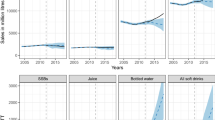Abstract
This paper uses a leading UK supermarket’s loyalty card database to assess the effectiveness and impact of the 2004 UK reduced salt campaign. We present an econometric analysis of purchase data to assess the effectiveness of the Food Standard Agency’s (FSA) ‘reduced salt campaign’. We adopt a general approach to determining structural breaks in the time series of purchase data, using unit root tests whereby structural breaks are endogenously determined from the data. We find only limited evidence supporting the effectiveness of the FSA’s reduced salt campaign. Our results support existing findings in the literature that have used alternative methodologies to examine the impact of information campaigns on consumer choice of products with high salt content.





Similar content being viewed by others
Notes
By convention, \( i_{0} = 0\;{\text{and}}\;i_{m + 1} = n. \)
Results have been obtained using R and the package strucchange.
More detailed results for individual series such as TS1 (crisp.lowsalt) and TS10 (butcher- schoice.baconS) and all complete results are available from the authors.
References
Andrews, D. W. K. (1993). Tests for parameter instability and structural change with un- known change point. Econometrica,61(4), 821–856.
Bai, J., & Perron, P. (1998). Estimating and testing linear models with multiple structural changes. Econometrica,66(1), 47–78.
Bai, J., & Perron, P. (2003). Computation and analysis of multiple structural change models. Journal of Applied Econometrics,18, 1–22.
Balcombe, K., Fraser, I. M., & Di Falco, S. (2010). Traffic lights and food choice: A choice experiment examining the relationship between food labels and price. Food Policy,35(3), 211–220.
Collins, M., Mason, H., O’Flaherty, M., Guzman-Castillo, M., Critchley, J., & Capewell, S. (2014). An economic evaluation of salt reduction policies to reduce coronary heart disease in England: A policy modeling study. Value in Health,17(5), 517–524.
Griffith, R., O’Connell, M., & Smith, K. (2017). The Importance of Product Reformulation Versus Consumer Choice in Improving Diet Quality. Economica,84, 34–53.
Hansen, B. E. (1997). Approximate asymptotic P values for structural-change tests. Journal of Business and Economic Statistics, 15(1), 60–67.
He, F. J., & MacGregor, G. A. (2009). A comprehensive review on salt and health and current experience of worldwide salt reduction programmes. Journal of Human Hypertension,23, 363–384.
Lee, J., List, J. A., & Strazicich, M. C. (2006). Non-renewable resource prices: Deterministic or stochastic trends? Journal of Environmental Economics and Management,51, 354–370.
Lee, J., & Strazicich, M. C. (2003). Minimum lagrange multiplier unit root test with two structural breaks. Review of Economics and Statistics,85(4), 1082–1089.
Lee, J., & Strazicich, M. (2004). Minimum LM unit root test with one structural break. Working Papers 04–17, Department of Economics, Appalachian State University.
Liu, P. J., Wisdom, J., Roberto, C. A., Liu, L. J., & Ubel, P. A. (2014). Using behavioral economics to design more effective food policies to address obesity. Applied Economic Perspectives and Policy,36(1), 6–24.
Mela, C. F., Gupta, S., & Lehmann, D. R. (1997). The long term impact of promotion and advertising on consumer brand choice. Journal of Marketing Research,34, 248.
Nghiem, N., Blakely, T., Cobiac, L. J., Pearson, A. L., & Wilson, N. (2015). Health and economic impacts of eight different dietary salt reduction interventions. PLoS ONE,10(4), e0123915. https://doi.org/10.1371/journal.pone.0123915.
Shankar, B., Brambila-Macias, J., Traill, B., Mazzocchi, M., & Capacci, S. (2013). An evaluation of the uk food standards agency’s salt campaign. Health Economics,22, 243–250.
Sutherland, J., Edwards, P., Shankar, B., & Dangour, A. D. (2013). Fewer adults add salt at the table after initiation of a national salt campaign in the UK: A repeated cross-sectional analysis. British Journal of Nutrition,110, 552–558.
Van Camp, D., de Souza Monteiro, D. M., & Hooker, N. H. (2012). Stop or go? How is the UK food industry responding to front-of-pack nutrition labels? European Review of Agricultural Economics,39(5), 821–842.
Webb, M., Fahimi, S., Singh, G. M., Khatibzadeh, S., Micha, R., Powles, J., et al. (2017). Cost effectiveness of a government supported policy strategy to decrease sodium intake: global analysis across 183 nations. The British Medical Journal,356, i6699.
World Health Organization. Global Status Report on Non-Communicable Diseases, 2014. http://apps.who.int/iris/bitstream/handle/10665/148114/9789241564854_eng.
Zivot, E., & Andrews, D. (1992). Further evidence of great crash, the oil price shock and unit root hypothesis. Journal of Business and Economic Statistics,10, 251–270.
Acknowledgements
Research funded by the UK Food Standards Agency (FSA Project Code: D03008). We would also like to acknowledge help received from Andrew Fearne in obtaining the dataset used in this paper.
Author information
Authors and Affiliations
Corresponding author
Additional information
Publisher’s Note
Springer Nature remains neutral with regard to jurisdictional claims in published maps and institutional affiliations.
Rights and permissions
About this article
Cite this article
Sharma, A., di Falco, S. & Fraser, I. Consumption of salt rich products: impact of the UK reduced salt campaign. Int J Health Econ Manag. 19, 341–357 (2019). https://doi.org/10.1007/s10754-018-9257-9
Received:
Accepted:
Published:
Issue Date:
DOI: https://doi.org/10.1007/s10754-018-9257-9




